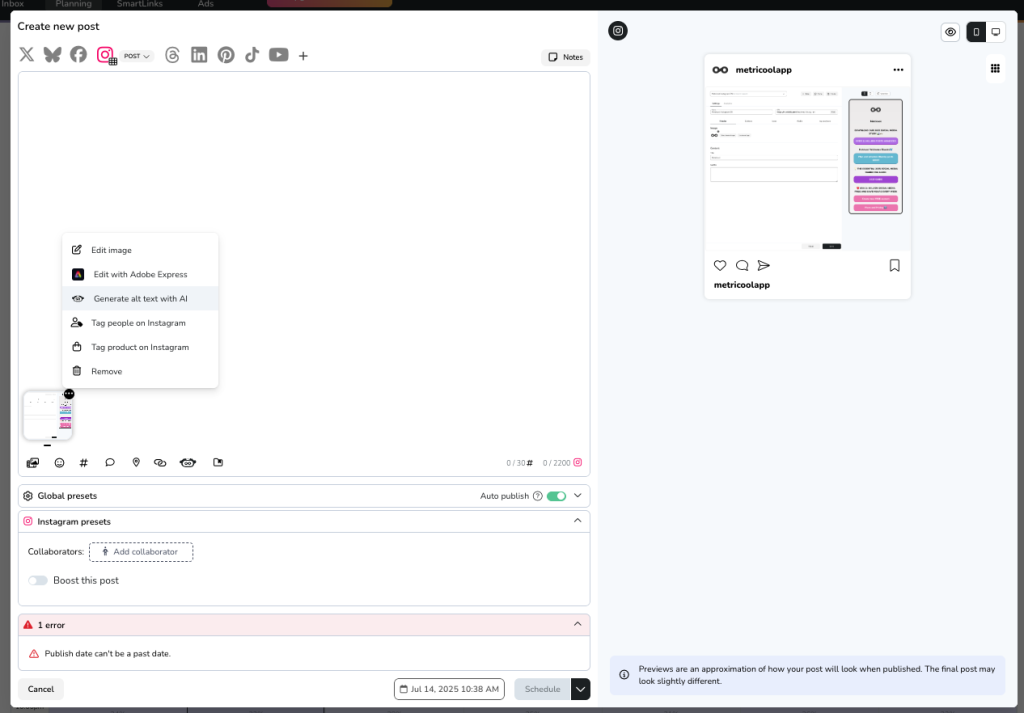Social Media Accessibility Guidelines and Best Practices

As social media continues to shape how we connect and communicate, it’s important to think about who gets to participate in those conversations. Accessibility in social media means making sure your content is usable and understandable for everyone, especially people with disabilities. From how readable your text is to how easy it is to navigate your content, there are several factors that contribute to a more inclusive experience. In this article, we’ll walk through what accessibility in social media really means, why it matters for your marketing strategy, and how you can start making your content more accessible to a wider audience.
What is Accessibility in Social Media?
Accessibility in social media means creating content that everyone can use and understand, including people with disabilities. It goes beyond adding alt text or captions. At its core, it’s about removing barriers so anyone can take part in the conversation, no matter how they access your content.
Start with readability. Use clear, straightforward language and organize your content in a way that’s easy to follow. Provide text alternatives for visuals, like images or videos, so users who rely on screen readers can understand the full message.
Next, look at your visual design. Use high-contrast color combinations, make sure text can be resized, and avoid relying only on color to communicate important information. These small changes can make a big difference for people with low vision or color blindness.
Navigation is equally as important. Your content should be easy to explore using tools like a keyboard or screen reader. That means clearly labeled buttons, functional links, and accessible menus. Offering content in more than one format, like including transcripts for videos or adding audio descriptions, also helps reach a wider audience.
Finally, inclusivity means listening. Ask for input from people who use assistive technology or have specific accessibility needs. Their feedback can help you create content that feels more thoughtful and easier to engage with.
When brands, creators, and platforms prioritize accessibility, they contribute to a digital space where more people can connect, learn, and engage.
Why Accessibility is Important for Social Media Marketing
Accessibility in social media is more than a thoughtful gesture. It’s an important part of any strong marketing strategy. Here’s why:
- Wider Reach: Over a billion people worldwide live with a disability. Making your content accessible opens your brand up to this wider group and makes your message more inclusive.
- Better User Experience: Accessible content is often easier to understand and interact with. Even users without disabilities benefit from clearer layouts, captions, and readable posts.
- Legal Compliance: Depending on where your business is based, digital accessibility may be required by law. Making your content accessible helps you stay compliant and avoid legal risks.
- Positive Brand Reputation: When you show that you care about accessibility, it reflects well on your brand. Users notice when you make the effort, which can build loyalty and trust.
- More Engagement: People are more likely to engage with content that’s easy to access. Whether it’s liking, sharing, or commenting, accessible content encourages more interaction.
How to Integrate Accessibility into Your Social Media Strategy
Incorporating accessibility into your social media doesn’t mean reinventing the wheel. Start with what you already do and adjust your process from there.
Train your team so everyone understands how accessibility works and why it matters. Choose platforms and design tools that support accessibility features like alt text and contrast checking. Even a quick audit of older posts can highlight what needs updating while showing your followers you’re serious about making improvements.
When planning content, don’t leave accessibility as an afterthought. Include captions, visual contrast, and readable fonts from the start. And if you’re unsure what’s working, ask. People who use assistive tech can offer feedback that goes beyond checklists and helps shape content that feels more inclusive and respectful.
Social Media Accessibility Checklist & Best Practices
If you’re looking to make your content more inclusive, start with the basics. These best practices help lay the groundwork for accessible social media posts that work for a wider audience.
- Use Clear Language: Avoid complex words or industry jargon. Aim for clarity and simplicity.
- Add Alt Text: Include brief, descriptive alt text for every image. This helps users who rely on screen readers understand the visuals.
- Use CamelCase for Hashtags: Capitalize the first letter of each word in a hashtag (#SocialMediaTips) so screen readers can read them properly.
- Caption your Videos: Add accurate captions for all video content. This supports users who are deaf or hard of hearing and helps anyone watching with the sound off.
- Limit Emojis: Emojis can be fun but use them in moderation. Screen readers say the name of each emoji, so too many can be distracting.
- Keep Contrast High: Make sure your text stands out from the background to help people with low vision.
- Avoid Flashing Visuals: Flashing or strobing graphics can cause seizures. If you must use them, always provide a warning.
- Use Content Warnings: For sensitive or potentially distressing content, add a brief warning so users can decide whether or not to view it.
- Choose Readable Fonts: Stick to simple, legible fonts and sizes. Avoid decorative or hard-to-read fonts, especially in images.
- Skip Non-Standard Fonts: Custom fonts used in bios or captions may not be readable by screen readers. Stick to native fonts to keep things inclusive.
Tips and Tricks for Improving Social Media Accessibility
Once you’ve got the fundamentals down, take it a step further. These simple tips can help fine-tune your content and improve the experience for everyone who comes across your posts.
- Add Extra Image Descriptions in Captions: Sometimes a little extra context helps users better understand the visual.
- Limit the Text Inside Images: Instead, place important info in the caption so screen readers can catch it.
- Test Your Content: Use screen readers and other tools to see how your content performs.
- Learn Each Platform’s Features: Platforms like Instagram, TikTok, and X (Twitter) all have built-in accessibility tools. Learn how to use them effectively.
- Make PDFs Accessible: Use headings, alt text, and proper tagging when sharing downloadable content.
- Offer Multiple Contact Options: Give people more than one way to reach out, such as email or chat.
- Use Specific Link Text: Instead of “click here,” write “see our social media tips” or something more descriptive.
- Combine Colors with Symbols or Text: Don’t rely only on color to get your point across.
- Stay Informed: Accessibility trends and tools are always evolving. Keep learning and adapting your strategy.
Metricool and Accessible Content
As you work towards more inclusive content, Metricool has tools that can help. From planning and scheduling posts to analyzing performance, you can manage your entire content strategy in one place while keeping accessibility front and center.
Now, there’s a new feature to make your workflow even easier: AI-generated alt text.
When you upload an image to Metricool’s planner, you can automatically generate alt text using AI by clicking the three dots in the upper right hand corner of your uploaded image. This helps you save time and make sure every image includes a description for users who rely on screen readers.

- On FREE and STARTER plans, this feature uses your available AI credits
- On ADVANCED and higher plans, AI alt text generation is included at no extra cost
It’s a fast and simple way to add context to your visuals and make your social media more inclusive without slowing you down.
With Metricool, you’re not just publishing content. You’re creating a presence that’s thoughtful, accessible, and easier to manage every step of the way.

